Professor Joseph Henry and the U.S. Lighthouse Service
AI-generated summary of this post
Audio summary (22 min) will open in a new tab. Generated with Gemini AI Audio Overview, Sept 9, 2025
Professor Joseph Henry’s (1797-1878) contributions to the U.S. Lighthouse Service represent a fascinating intersection of scientific innovation and public service. Henry – celebrated as a pioneering American physicist and the first Secretary (director) of the Smithsonian Institution– also played a crucial role in the modernization of America’s lighthouse system, particularly through his work at the U.S. Lighthouse Depot (Third Lighthouse District) on Staten Island, New York. Under Henry’s leadership, the Smithsonian became a hub for scientific research and education. He was instrumental in establishing the Smithsonian’s policy of publishing scientific research, which helped disseminate new knowledge to the broader public. At the Smithsonian Henry also advocated for the establishment of a national weather service, recognizing the importance of meteorological data for public safety and scientific inquiry. His efforts in this area contributed to the eventual creation of the U.S. Weather Bureau. However, his contributions to the U.S. Lighthouse Service are equally noteworthy, particularly his experiments and innovations that took place at the Staten Island depot.
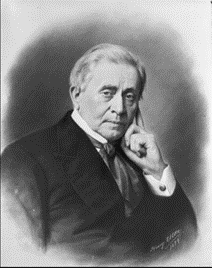
Professor Joseph Henry – An 1879 version of a portrait originally painted by Henry Ulke in 1875 and hung for many years in the Smithsonian Institution building or ‘Castle’ which also served as the Henry family home. Smithsonian Institution Archives. https://siris-sihistory.si.edu
Joseph Henry: A Scientific Mind in Public Service
Joseph Henry’s contributions to the field of science are numerous and far-reaching. On the raised balustrades of the main reading room of the Library of Congress are 16 bronze statues that exemplify the different branches of knowledge. The two men representing the sciences are Isaac Newton and Joseph Henry, the latter honored as the first prominent American scientist since Benjamin Franklin. His most significant work was in the field of electromagnetism where he conducted pioneering experiments that laid the groundwork for the development of electrical technologies. In the 1820s and 1830s while teaching at the Albany Academy his theoretical insight to wind insulated wire into multiple tightly packed coils significantly increased the strength of the magnetic field generated by an electric current to create the strongest electromagnets of his time (lifting more than a ton). [1] In 1831 Henry also constructed two electromagnets for the Penfield Iron Works company near Crown Point New York. By using these magnets to extract iron from pulverized iron-bearing ore the company established the first industrial application of electricity.[2][3]
Henry emphasized the pedagogical use of his electromagnets (demonstrations for effective teaching) but also suggested their practical applications. He invented the electromagnetic doorbell and used an electromagnetic relay to send signals over a mile of wire, disproving the belief that electricity could not travel long distances. This breakthrough laid the groundwork for the telegraph system. Both Samuel Morse and Alexander Graham Bell consulted with Henry, who encouraged them both to pursue their respective inventions of the telegraph and telephone. Henry’s electromagnets also paved the way to a better understanding of electromagnetism.[4]
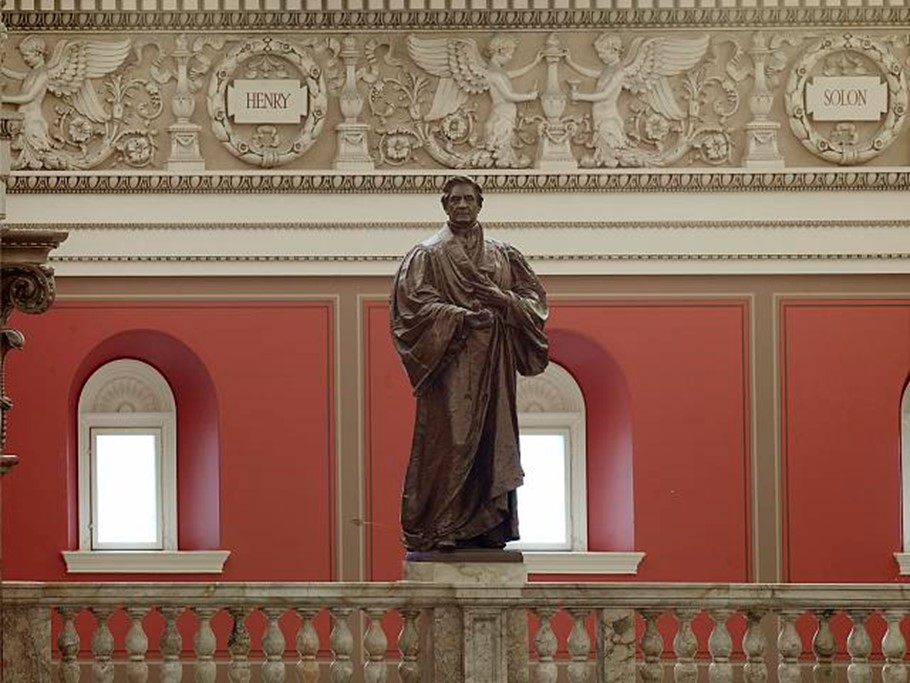
Portrait statue of Henry along the upper balustrade of the Library of Congress main reading room. Library of Congress, Thomas Jefferson Building, Washington, D.C. https://www.loc.gov/pictures/item/2007684402/
One of Henry’s most notable achievements was the discovery of electromagnetic induction in 1832. He is credited for discovering self-induction a property of a coil or circuit that allows it to oppose changes in the current flowing through it. When the current in a coil changes, it creates a magnetic field, which then induces a voltage (called an electromotive force or EMF) in the same coil, resisting the change in current. Modern devices with an electronic circuit are designed to manage the potential detrimental effects of self-inductance, while some electronic circuits take advantage of the beneficial effects of self-inductance such as creating tuning circuits in radios or circuits to block high-frequency noise. Although the English scientist Michael Faraday is often credited with the discovery of mutual induction, Henry independently discovered the same phenomenon around the same time in America. If you ever charged your cellphone with a wireless charger, then you were taking advantage of mutual inductance. In mutual induction, a coil carrying an electrical current (your charging base) acts as a transmitting coil by creating a magnetic field that induces a charging current in a nearby receiver coil (your cellphone). Mutual inductance also makes motors, transformers, and generators possible. In recognition of the contributions of Joseph Henry and Michael Faraday to the understanding of electromagnetism, the International System of Units (SI), the modern form of the metric system, includes two units of measurement named after both scientists. The henry (H) is the unit used to measure inductance, while the measure of capacitance is the farad (F).
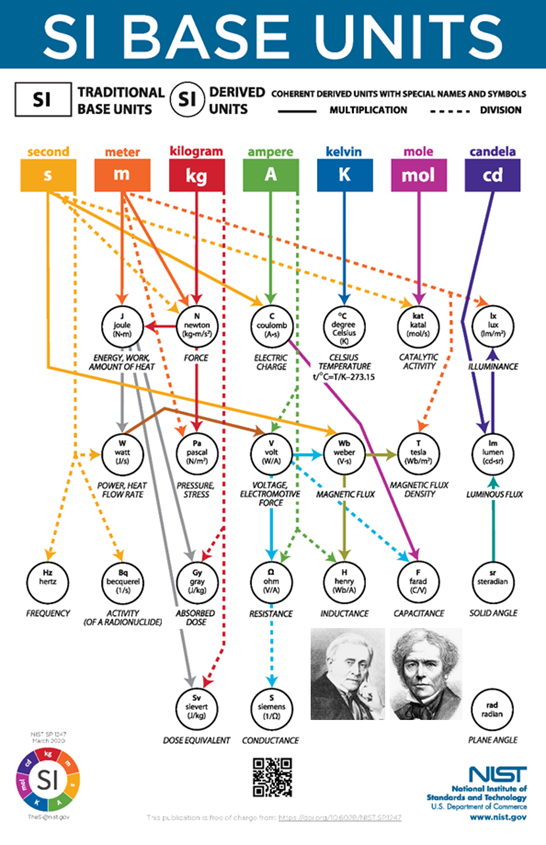
A poster from the National Institute of Standards and Technology (U.S. Department of Commerce) showing the 7 base units of the metric system and the units of measurement that are derived from these base units, including the henry and farad (added images of Henry and Faraday are from Wikimedia Commons). One henry is the unit of inductance and is derived from the base units of seconds, meters, kilograms, and amperes and is defined as 1 H = 1kg x m2 / s2 x A2
Henry never filed a patent for his discoveries and often did not pursue them further. His primary motivation was to generate basic scientific discoveries that may or may not be applied by others to a useful purpose. But he defended his priority when he felt that the value of his contributions was not acknowledged in scholarly publications. An example is his invention of what would be among the earliest moving machines powered by electricity that he called a “philosophical toy”:
I have lately succeeded in producing motion in a little machine, by a power, which, I believe has never before been applied in mechanics – by magnetic attraction and repulsion. Not much importance, however, is attached to the invention, since the article, in its present state, can only be considered a philosophical toy; although in the progress of discovery and invention, it is not impossible that the same principle, or some modification of it on a more extended scale, may hereafter be applied to some useful purpose.[5]
Useful purpose indeed! Although it is difficult to determine who was influenced by Henry’s original idea of reversing polarity in electromagnets to maintain a constant current, his method was a clear precursor to the rotating commutator – a critical component for the creation of the direct current (DC) motor and DC generator. When Henry heard of a continuously revolving electromagnet invented by British experimentalist William Ritchie (considered by many to be the inventor of the commutator), he implied that Ritchie failed to give him credit for his original idea – “[Ritchie] lately reinvented my machine.”[6]
Nonetheless, it is quite likely that Ritchie came up with the idea independently of Henry. The scientific community, after all, was reading the same scientific literature and enthusiasm about the recent advances in electromagnetism was growing feverish.
Professor Henry's Philosophical Machine
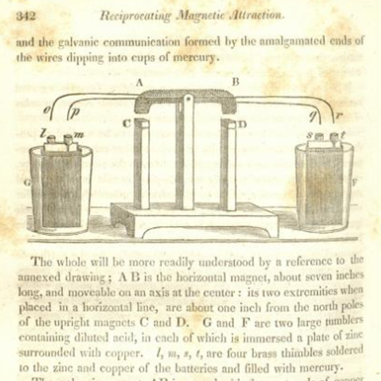
Henry’s ‘philosophical toy’
Diagram from Henry’s publication in The American Journal of Science and Arts, 1831, Vol. 20, p. 342.
Henry’s ‘philosophical toy’ was an electrically-controlled machine producing steady motion by the continual reversal of the polarity of an electromagnet. The two containers in the drawing are voltaic cells (today we call them batteries). When electrified the horizontal coiled metal rod (A-B) – resting on a swivel above two standing permanent magnets with like poles (C and D) – behaves like a teeter-totter or seesaw. Two pairs of wires extend from both sides of the coiled metal rod. When the left side wires are dipped into the left voltaic cell, current flows through the coiled metal rod magnetizing it and creating the same polarity at A as on the permanent magnet C (and opposite polarities, and therefore attraction, at B and D) which causes the rod to deflect lifting the left-side wires out of the voltaic pile, but dipping the right-side wires in the other voltaic cell. The wires on the other voltaic cell are wired to reverse the polarity of the electromagnet (A-B) causing a repulsion and attraction again but in the opposite direction. This reciprocating or rocking action continued until the voltaic cells were exhausted.
There were times when Henry may have regretted not publishing his many findings expeditiously (he was often occupied with his heavy teaching duties) or for not pursuing further an interesting scientific observation as suggested in a diary entry by his daughter Mary Henry:
Father has been looking over one of his old books tonight in which are recorded some of the experiments he made while at Princeton. The review has made him somewhat sad. He spoke of one experiment upon the effect of electricity encircling a ray of light. It failed for want of sufficiently strong galvanic battery. Five years later, Faraday made the same experiment, succeeded & gained the plaudits of the scientific world. I do not exactly understand the experiment shall ask for an explanation.[7]
'Father has been Looking over one of his old books . . .'
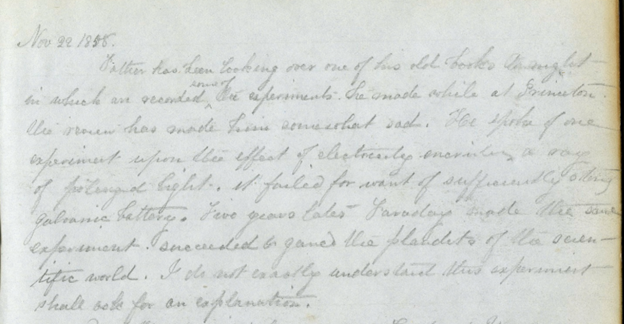
First entry, dated Nov 22 1858, in Mary Henry’s Diary, 1858 – 1863. The experiment referred to by Mary Henry may be the Faraday 1845 experiment confirming that light and electromagnetism are related phenomena by showing that a magnetic field can rotate a beam of polarized light. Later James C. Maxwell would establish that light consists of electromagnetic waves through his electromagnetic theory represented by his 4 famous equations. (Note that the term ‘theory’ when used correctly in science does not refer to a hunch, educated guess, or hypothesis, but to an explanation of natural phenomenon that is supported by direct empirical evidence.)
However, Henry’s influence extended beyond basic and theoretical science in electromagnetism and into practical applications that had a profound impact on public infrastructure, including in the realm of maritime safety.
In 1852, while serving in his sixth year as the Secretary of the Smithsonian Institution, Henry was appointed to the U.S. Lighthouse Board, a newly established body tasked with reforming the nation’s lighthouse system, which had been plagued by inefficiencies and outdated technology.[8][9] Professor Henry was one of the board’s two civilian scientific members (the other was Professor Alexander Bache, the grandson of Benjamin Franklin, a close friend of Henry, and Superintendent of the U.S. Coastal Survey).[10] In his new role Henry accepted the responsibility of overseeing experiments and technological developments aimed at improving lighthouse illumination and fog signaling systems. Later, in 1871, Professor Henry was appointed to succeed Rear Admiral Shubrick as chair of the Lighthouse Board overseeing the board’s $1.6 million budget and a workforce that included over 800 lighthouse keepers. Professor Henry served in this capacity while still conducting experiments (mostly during his vacation time from the Smithsonian Institution) until his death in 1878.[10][11]
The other members of the first Lighthouse Board
The other members of the first Lighthouse Board were: Commodore William B. Shubrick, E.S., Navy, chairman; Brevet Brig. Gen. Joseph G. Toten, Chief Engineer, U.S. Army; Lieut. Col. James Kearney, U.S. Corp of Engineers; Professor A.D. Bache, LL.D., Superintendent Coast Survey, Commander S.F. Dupont, U.S. Navy. The secretary of the Treasury, Hon. Thomas Corwin, was Ex Officio President.
The U.S. Lighthouse Depot on Staten Island
In the mid-19th century, the U.S. Lighthouse Service (USLHS) identified the need for a central depot to manage the logistics of lighthouse operations, including the storage of equipment, fuel, and the development and testing of new technologies. In 1863, Congress appropriate funds to establish the Lighthouse Depot on Staten Island, New York, in a section of Tompkinsville (now St. George).[12] This site became a hub for the development and refinement of lighthouse technology under the guidance of Joseph Henry.
The depot consisted of many buildings, some of which still stand today, though many are in disrepair. Among these structures is Building 6, the first storehouse built by the USLHS in 1864 and a site of significant historical interest where Henry conducted some of his impactful experiments on oils used for illuminating lighthouses, as well as experiments to develop better sound warning signals such as foghorns.
The buildings of the Lighthouse Depot Grounds in 1965
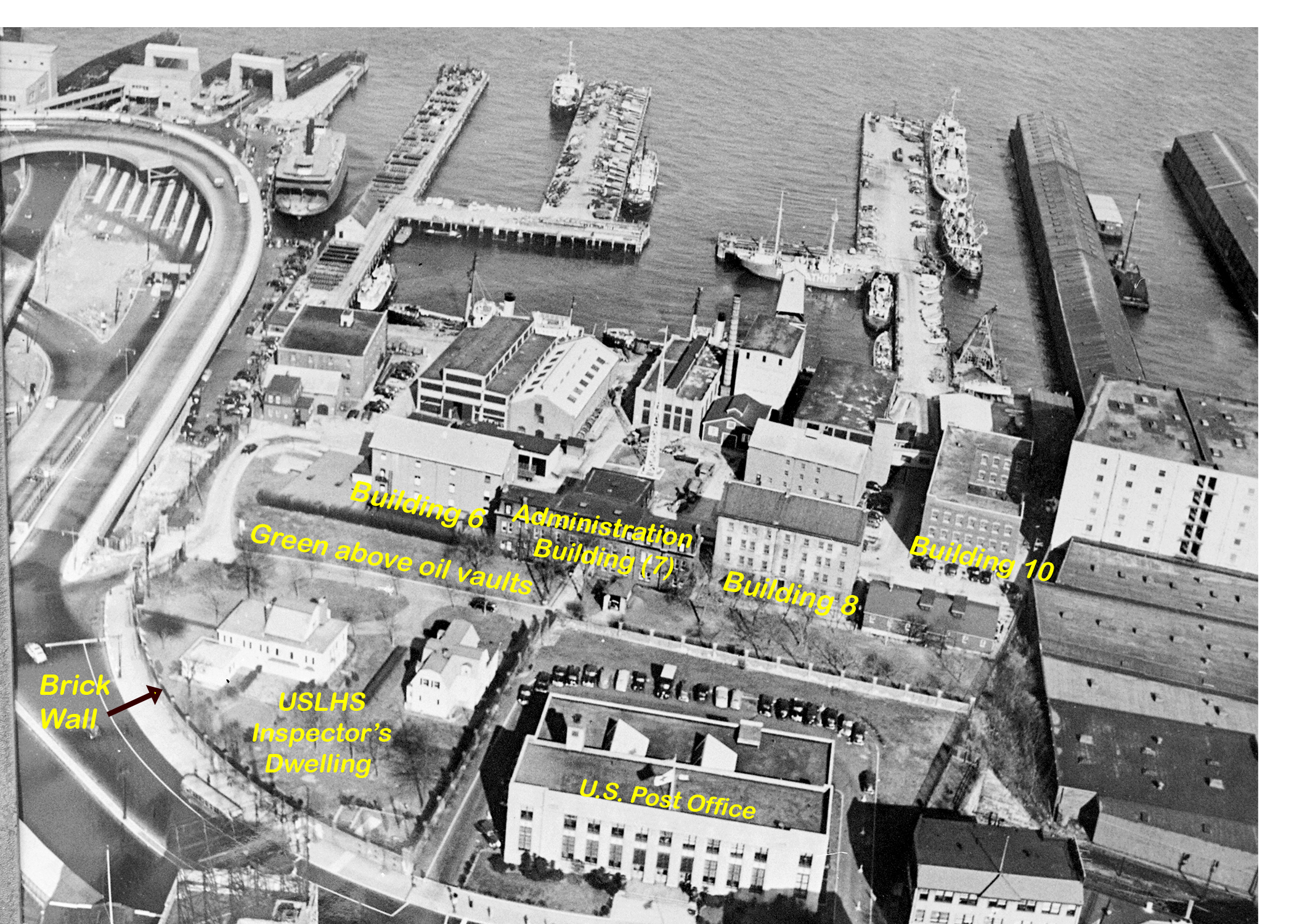
St George Coast Guard Base, 1965
The U.S. Lighthouse Service (USLHS) depot grounds transitioned into the U.S. Coast Guard Base on July 1 1939 when the two government maritime services merged and the Coast Guard took over the responsibility of the nation’s lighthouses. This photo was taken a year before the coast guard moved to Governors Island in 1966 making the the Staten Island facility surplus government property. Among the original 5 acres of the former Quarantine grounds once owned by the federal government, the U.S. post office is the only remaining structure. The buildings mentioned in the text are labeled. Building 11 which houses the National Lighthouse Museum is not viewable, being obscured by Building 10. All of the labeled structures are still standing except the USLHS Inspector’s Dwelling replaced by a residential tower standing tall above retail space in Phase 1 of the Lighthouse Point mixed-use development project. Only a small section of the historic brick wall was preserved in the the Lighthouse Point project.
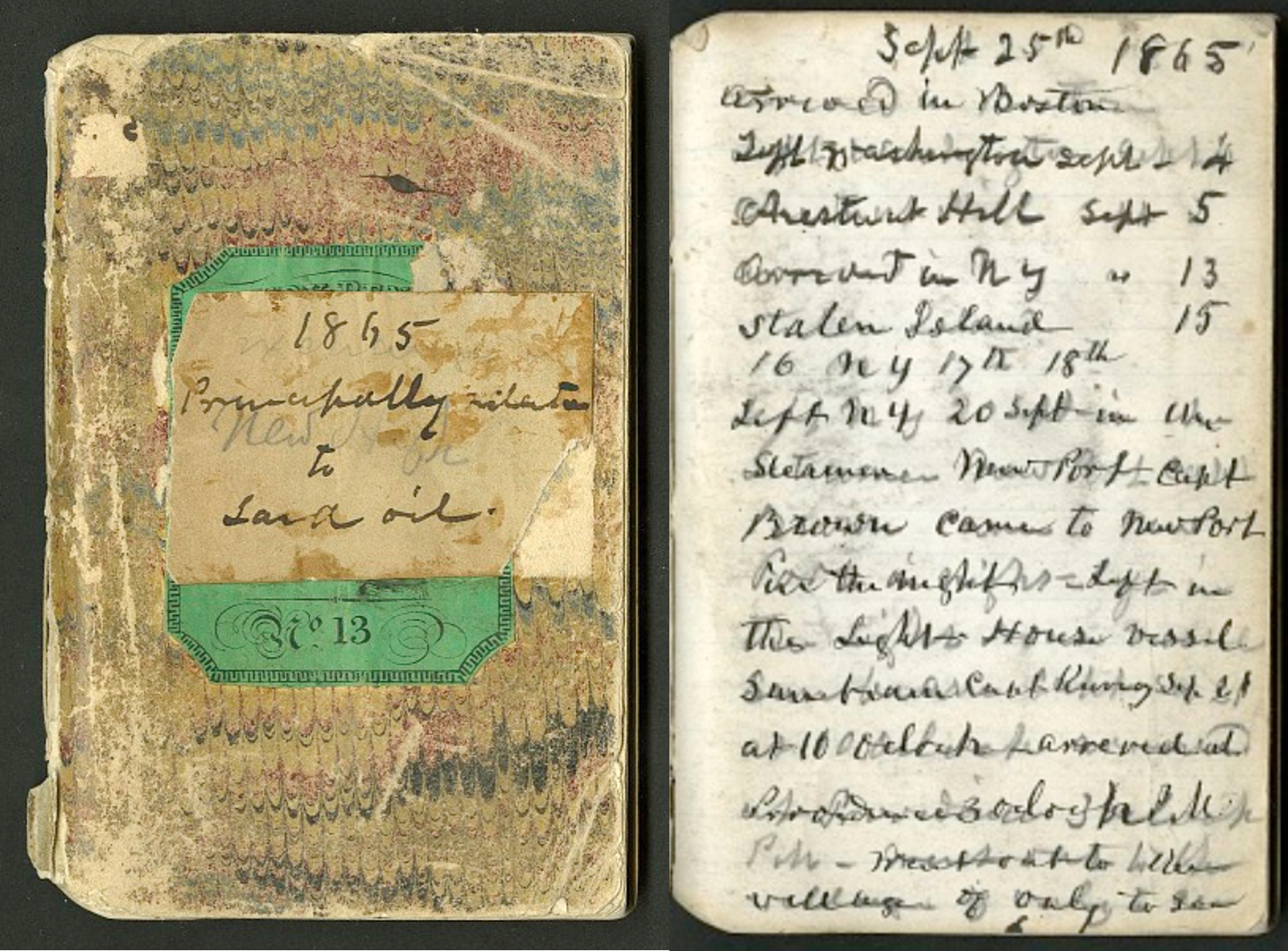
In his laboratory notebook dedicated to his lard oil experiments Joseph Henry wrote that he was at Staten Island in 1865 from September 15th to the 18th.[13]
Joseph Henry’s involvement in planning the lighthouse depot grounds is evident in several surviving letters and reports. In a June 6 1864 report by a special committee of the board consisting of Joseph Henry and C. H. Davis, changes to the Lighthouse engineer’s depot construction plans are proposed, including changing Building 6 from an orientation perpendicular to the depot ground’s shore line to the parallel orientation, as it continues to stand today, with the front facing the bay to the east.[14]
In an October 25 letter to the chairman of the lighthouse board Rear Admiral William B. Shubrick, lighthouse inspector L.M. Powell comments that “No boat-house has been built for the service of the light-house establishment, though one was promised by the supervising architect of the Treasury Department in his letter to Professor Joseph Henry, dated June 24, 1863.”[15] An 1866 entry in his lard oil laboratory notebook Henry wrote: “Com. Powell proposes to dig a [cellars] into the bank in the rear of the Depot at S.I. for oil to be covered with row beams and brick arches.” [13] The Lighthouse board’s annual report for this same year stated that “Estimates are also offered for the establishment of oil vaults of sufficient capacity for the safe storage of the annual supply of oil. This is a facility the want of which has been much felt, and which will materially lessen the expense of handling and leakage.”[16][17] These vault structures still exist west of Building 6, albeit in poor condition, as well as a small laboratory building between Building 6 and the oil vaults built after 1874 but before 1887.
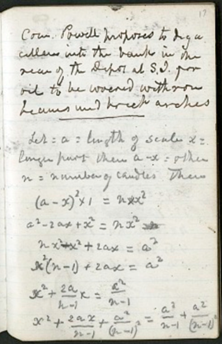
“Com. Powell proposes to dig a [cellars] into the bank in the rear of the Depot at S.I. for oil to be covered with row beams and brick arches.” The equations worked out on this page and the next (not shown) may be related to Bunsen photometer tests comparing the brightness of two lamps (measured in candles) burning two different fuel oils. [13]
It was in the landmarked Administration building where Joseph Henry would first experience symptoms of the kidney disorder that would end his life. In his presidential address to the National Academy of Sciences on April 16, 1878 a very feeble Joseph Henry insisted on attending the opening session but had an officer read his welcome statement explaining that “After an almost uninterrupted period of excellent health for fifty years I awoke on the 5th of December, in my office at the Light-House Depot on Staten Island, finding my right hand in paralytic condition.” Joseph Henry also offered his resignation as president of the National Academy of Sciences, but his offer was declined by the membership consisting of the most distinguished American scientists.[20][21] Professor Joseph Henry died from chronic nephritis (known as Bright’s disease in his day) on May 13, 1878. He was buried in Rock Creek Cemetery in Washington D.C.
These historic buildings on the former lighthouse depot grounds as well as building 11 currently housing the National Lighthouse Museum and building 10, targeted for the museum’s future expansion, were integral to the operations and innovations that shaped the future of lighthouse technology.
Henry’s Experiments at the Depot
Henry’s scientific rigor and commitment to empirical research were evident in the experiments he conducted at the Staten Island depot. One of his key contributions was the exploration of alternative fuels for lighthouse illumination. While conducting field experiments in a Boston lighthouse Henry wrote to his wife Harriet explaining the importance of his experimental work for the lighthouse board
I am now in the Office of the Board and putting in operation the experiments, for which I came to Boston. The business is quite a pleasant one since I have, under my direction, a number of very active and intelligent men; all anxious to do my bidding. I am much gratified with the success that has, thus far, attended our efforts to lessen the expense of the illumination of our coast, since, whatever tends to facilitate the Light House system, is a boon to humanity. No one, who has not experienced the feeling, can imagine the joy of the storm-threatened mariner in beholding, after months it may be, of absence of all indications of land, the anxiously looked for beacon of safety and of home. Thousands of lives often depend on the permanency and efficiency of a single light. Great care and attention must be had in selecting the proper material for burning, the best machinery and the most trustworthy agents to carry on the operations. The Board must also be men of high intelligence, irreproachable character and jointly of varied scientific knowledge. The yearly cost of oil is about 140,000 dollars and, the whole expense of the system of our lights, is upwards of a million of dollars annually. The introduction of lard oil, which has been the object of my experiments, will save the government this year about 40,000 dollars.[22]
Not only were people’s lives at stake, but also the health of the commerce of the country. At the time, sperm whale oil was the primary fuel used in lighthouse lamps, but its high cost prompted Henry to investigate lard oil as a cheaper but effective substitute. Through meticulous controlled experiments in Building 6, Building 8, and his laboratory at the Smithsonian Institution, Henry determined that with proper modifications to the lamp design, lard oil could be effectively used, leading to significant cost savings for the Lighthouse Service.
Lard Oil Experiments in Building 8
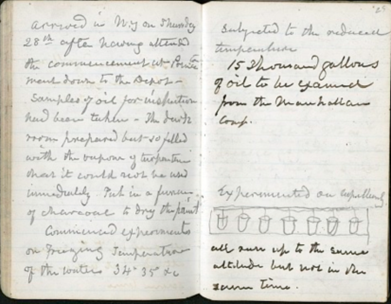
Undated Lard Oil Laboratory notebook pages [13]
Left page. Arrived in N. Y. on Thursday 28th after having attended the commencement at Princeton. Went down to the Depot- Samples of oil for inspection had been taken – the dark room prepared but so filled with the vapor of turpentine that it could not be used immediately. Put in a [furnace] of charcoal to dry the paint.
Commenced experiments on freezing temperature of the water 34o 35o x 6
Right Page- top. subjected to the reduced temperature. 15 thousand gallons of oil to be examined from the [????] comp.
Right page- bottom. Experimented on Capillarity. all [run] up to the same altitude but not in the same time.
** The diagram represents experiments conducted on capillary action – the movement of several oils within the wicks used in the lamps. Earlier experiments by Henry and others indicated that lard oil was a poor luminant, however Henry realized that the problem was not with how bright the oil burned, but with the lack of ease with which the oil traveled up the lamp wicks. By changing the structure of the lamps to help the lard oil capillarity Henry was able to show that lard oil was superior to other oils and saved considerable monies by switching to lard oil. Later when lard oil also became expensive, similar experiments were conducted to switch some lighthouse lamps to mineral oil. **
In addition to his work on illumination, Henry was also at the forefront of developing more effective fog signals. Recognizing the dangers that fog posed to maritime navigation, Henry’s research focused on optimizing the transmission of sound in foggy conditions. Writing as the chairman of the lighthouse board in 1874 he began a detailed report of the many experiments conducted with the statement:
Among the impediments to navigation none are perhaps more to be dreaded than those which arise from fogs, and consequently the nature of this impediment and the means which may be devised for obviating it are objects of great interest to the mariner.
Investigations, therefore, as to the nature of sound and its application to fog-signals become an important object to those in charge of aids to navigation.
Professor Henry had an early interest in acoustics.[23] In 1856 his interest in sound was put to the test when congress requested that a new lecture hall be designed for the Smithsonian. His work on the design requirements involved qualitative investigations of the various factors that influence the persistence of sound in auditoriums called “reverberation”.[24] According to some historians this work was the beginning of the scientific study of architectural acoustics in the engineering sciences.[25] Henry’s trained ability to identify sound reverberations in rooms proved useful when a concerned President Abraham Lincoln asked him for a personal favor. Mary Todd Lincoln began receiving visits at the White House from spiritualists to communicate with her recently deceased son. Henry agreed to Lincoln’s request to investigate one of his wife’s favorite spiritualists. Charles Colchester, who claimed to communicate with spirits by summoning noises from different locations in a room, was invited to the Smithsonian Institution to perform a private séance for Professor Henry. During the séance Henry concluded “I do not know how you make these sounds, but this I perceive very clearly – they do not come from the room but from your own person.” The mechanism used to make the sounds could not be determined because Colchester refused to undress. In her diary Mary Henry describes a similar investigation by her father of another spiritualist and coming to the same conclusion:
Father asked him if he could make the spirits rap as other media can. He said he could and produced some raps so well executed that if Father had not made as many experiments as he has in sound he would have sworn that they came from a certain part of the room. As it was, he was convinced that they came from the man himself. After some experiments, he told the medium so.[26]
Henry later learned of the likely mechanism used by these spiritualists on a train ride during a conversation with a maker of electrical instruments who recognized the famous inventor of powerful electromagnets. Among the many electrical devices that his fellow passenger manufactured were those used by spiritualist to deceive their patrons. He also revealed that he built a device for Colchester that wrapped around the biceps and generated noise when the biceps were contracted without moving the arm.10]
Foghorns and atmospheric acoustics
When the question of foghorns came up on the lighthouse board Henry’s interest and expertise in the empirical study of sound expanded to detailed experimentations on fog signals and atmospheric acoustics. The experiments conducted by Professor Henry began in 1865 in New Haven Connecticut. They were conducted on land and, more importantly, at sea on the vessels of the lighthouse board.
Numerous experiments examined the sound produced by various instruments (e.g., bells, steam-whistles, trumpets), sound reflectors, and hot air engines. The sounds were not only listened to, but also measured objectively with an “artificial ear” consisting of a device with a thin membrane covered with sand. The pattern of disturbance of the sand caused by the sound of various instruments and at different distances indicated “the penetrating power of the instrument under trial.” The results of these experiments were often complex and strange. For example, sound moving against the wind was often inaudible at the deck level but could be heard at the mast-head above, suggesting that upper air currents carry sound more effectively than lower ones and that sound waves can bend as they travel. This bending or redirection of sound waves is called refraction. Henry observed that wind refraction is less with continuous sounds, such as from a horn or whistle, compared to intermittent sounds, such as from a bell. His observations also confirmed that during storms, sound could be carried in a direction opposite to the wind at the surface, likely due to opposing upper air currents. Experiments provided mixed results on whether fog deadens or improves the propagation of sound, with some evidence pointing to the influence of air currents rather than fog density itself. Another series of experiments was conducted at Sandy Hook New Jersey with a steam siren beginning in 1867 and continuing intermittently into 1874. Which foghorn instrument was most effective depended on many factors including the physical characteristics of the site and the type of atmospheric conditions. In their report Henry and his fellow board members recommended the siren as a primary fog signal, in addition to the reed-trumpet and locomotive whistle. Large bells were retained for locations where fog-signals needed to be heard at shorter distances.[27]
Henry’s research on fog signals gained attention in Great Britain when physicist John Tyndall undertook a series of experiments in South Foreland England near Dover in the spring of 1873 for Trinity House (the US Lighthouse Service equivalent in Great Britain). Tyndall had visited the United States in 1872 on the invitation of Professor Henry and the Smithsonian Institution. During his tour of America Tyndall was able to examine Henry’s sirens at the Staten Island Depot and at Sandy Hook. Having heard of Tyndall’s research plans from Major Elliot of the US Army, Professor Henry and the Lighthouse board sent Tyndall “on their own spontaneous kindness” a steam siren for his use. This instrument became crucial in Tyndall’s investigations and he would eventually favor the use of the siren for most situations such that by 1779 twenty-eight of these powerful sirens were installed along the English coast to the chagrin of local inhabitants complaining of “… those demoralized and brutalized sirens.”[28]
In the third edition of his popular book “Sound” first published in 1875, Tyndall inserted a new chapter on his foghorn experiments and rewrote the preface describing his take on Henry’s 1874 Lighthouse Board report.[29] Tyndall began with praise of Professor Henry:
It is quite evident from the forgoing that, in regard to the question of fog-signaling, the Lighthouse board of Washington have not been idle. Add to this the fact that their eminent chairman gives his service gratuitously, conducting without fee or reward experiments and observations of the character here revealed, and I think it will be conceded that he not only deserves well of his own country, but also sets his younger scientific contemporaries, both in his country and ours, an example of high minded devotion .( p.12)
But Tyndall went on to challenge Henry’s explanation that the anomalies in fog signals were due to the refraction (or bending) of sound waves. Tyndall instead explained anomalies in the transmission of fog signals – for example, sounds in the identical location that may be heard on some days but not on other days despite clear conditions – as resulting from invisible clouds of water vapor that “have nothing whatever to do with ordinary clouds, fogs, or haze.” He called these inferred entities “acoustic clouds” and suggested that when they are dispersed in the atmosphere the traveling sounds that encounter a cloud are scattered and absorbed to lessen or destroy the sound. Moreover, he noted that the amount of scatter caused by “sound clouds” was greatest for high frequency (short wavelength) sounds. Tyndall, in fact, is credited for explaining why the sky is blue through his observations and laboratory experiments (subsequently studied in more detail by Lord Rayleigh). He determined that when the white light from the sun passes through the atmosphere the blue color component (which has a short wavelength) is scattered by molecules of gases and other particles more than the other colors, causing blue to dominate the sky. Therefore, while Henry informed his explanation of foghorn anomalies from his experience with the redirection of sounds in rooms, Tyndall informed his explanation of foghorn anomalies from his experience with light waves scattered by air particles. Moreover, while Henry interpreted his observations as consistent with the concept of sound refraction as proposed by other investigators (George Stokes in 1857 for wind-caused refraction and Osborne Reynolds in 1874 for wind- and temperature-based refraction),[30][31] Tyndall rejected these investigators’ explanation despite obtaining similar observations as professor Henry. Tyndall’s preferred explanation of “sound clouds” was based on a decades-old explanation based on the concept of “non-homogeneous atmosphere” (which he renamed flocculence). Tyndall attributed the effectiveness of the siren as a fog signal to its power in pushing sounds more efficiently through the “acoustic clouds.” Tyndall’s explanation also suggested that the use of low frequency sounds would better enable sound to travel through “acoustic clouds”. Interestingly, the familiar bellowing sound of modern foghorns are low-frequency (long wavelength) sounds. But light waves and sound waves differ in substantial ways. Refraction of sound is well accepted today in the atmospheric sciences, with variation in wind speeds and temperature accounting for most of the atmospheric sound anomalies, while in the absence of wind on clear days temperature has the primary effect on the propagation of sound.[32]
In the preface of his 1875 book on sound Tyndall briefly pivoted into the discussion of the philosophy of science and the problem of authority in science, explicitly identifying Henry as complicit as an authority that steered the scientific community in the wrong direction about the physics of atmospheric sound – “Authority caused me for weeks to depart from truth, and to seek counsel among delusions (p. 21) .“ A review of Tyndall’s book by The North American Review praised the majority of the book’s content but defended Professor Henry with a scathing review of the “ill-advised preface” and the long-winded added chapter on fog signaling.[33] Henry wrote to Tyndall in the summer of 1875 to thank him for sending him the third edition of the Sound book but commented that he experienced “mingled feelings of gratification and sorrow [from reading the preface]. With gratification on account of the kind manner with which you have spoken of me, for I value very highly your friendship and good opinion; and with sorrow on account of the annoyance which apparently my dissent from your views has occasioned you.”[26][34]
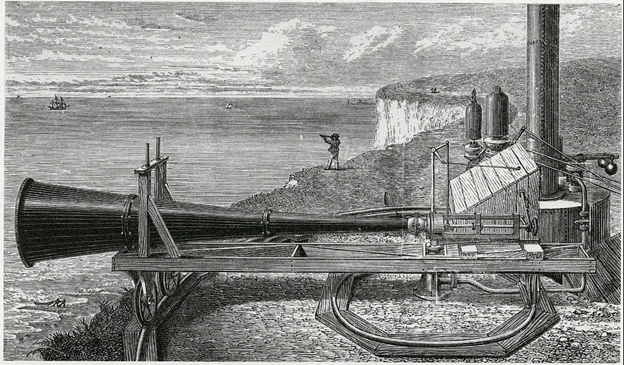
Illustration of a siren fog signal printed as a front piece in Tyndall’s third edition of “Sound” (1875/1895). This is the type of siren that professor Henry sent to Tyndall to include in his foghorn experiments and which were subsequently installed throughout the sea coast of Great Britain.
The Legacy of the Staten Island Depot and Joseph Henry
The U.S. Lighthouse Depot on Staten Island represents a critical chapter in the history of maritime navigation in the United States and Joseph Henry’s contributions were instrumental in transforming lighthouse technology. His experiments at the depot not only improved the safety and efficiency of lighthouses but also demonstrated the application of scientific principles to solve practical problems—a hallmark of Henry’s career. The legacy of Joseph Henry also offers valuable insights into the role of interdisciplinary research and its impact on public infrastructure and how scientific inquiry can drive technological innovation and contribute to the public good.
Today, the National Lighthouse Museum, housed in Building 11 of the former USLHS depot, continues to preserve and interpret the history of the Lighthouse Service and the coast guard which moved into the depot grounds in 1939 and took over responsibility for the nation’s lighthouses. However, many of the other depot buildings where Professor Henry and his colleagues conducted their groundbreaking work remain in need of preservation. On the northwestern section of the old Lighthouse depot grounds immediately west of the oil vaults once stood the old lighthouse inspector residence originally built by the U.S. Revenue Service in the early 1800s. The section of this USLHS residence ground situated directly above the vaults was maintained as a green and it once held a court for lawn tennis, a game introduced in the U.S. by the Outerbridge siblings on the Camp Washington grounds immediately north of the depot grounds (where the ferry terminal and Empire Outlets are located.) The old inspector’s residence was demolished by the city when the abandoned and neglected dwelling fell into disrepair and invited homeless squatters, but the green area (and a small section of an historic brick wall that once enclosed the depot grounds) will remain in a much-delayed mixed-use redevelopment project known as the Lighthouse Point. The original plan of this economic development project was to incorporate the abandoned buildings and oil vaults where Joseph Henry worked, but the plans were altered for economic reasons and they are not included in the nearly completed Phase I of the project. Whether a planned Phase II of this project, which includes the rehabilitation and repurposing of these historic buildings, will be realized is uncertain.[35] Restoring these structures would not only honor the historical significance of the former lighthouse depot but also serve as a tribute to the scientific contributions of Joseph Henry.
Conclusion
Henry’s legacy offers a compelling case study in the integration of scientific research with practical applications. As we reflect on the history preserved at the National Lighthouse Museum and the still-standing, albeit deteriorating, former depot buildings, we are reminded of the enduring impact of scientific innovation on society. Preserving this place and its history is not only about honoring the past but also about inspiring future generations to continue the tradition of using science for the public good.
References
[1] Henry, J. (1831) An account of a large electro-magnet, made for the laboratory of Yale College. American Journal of Science, April, Vol, 20, pp. 201-203.
[2] Davenport, W.R. (1929) Biography of Thomas Davenport, the “Brandon blacksmith”, inventor of the electric motor. Montpelier: The Vermont Historical Society.
[3] Penfield Homestead Museum. Railroads kick start the Age of Iron. https://passageport.org/journey/the-story-of-iron-in-crown-point-moriah/6-penfield-homestead-museum/, accessed September 9, 2024.
[4] Moyer, Albert E. (1997). Joseph Henry: The rise of an American scientist. Washington: Smithsonian Institution Press.
[5] Henry, Joseph (1831) On a reciprocating motion produced by magnetic attraction and repulsion, The American Journal of Science and Arts, Vol. 20, July, p. 340 – 343. Downloaded from the Biodiversity Heritage Library, https://www.biodiversitylibrary.org/item/54135#page/353/mode/1up
[6] Sherman, R. Joseph Henry’s contributions to the electromagnet and the electric motor. Smithsonian Institution archives, https://siarchives.si.edu/
[7] Mary Henry Diary, 1858 – 1863. Smithsonian Institution Archives, Record Unit 7001, Box 51, Folder: 3, Mary Henry Diary, 1858-1863 (si.edu)
[8] Thirty-Second Congress, August 31, 1852. An act making appropriations for Light-houses, light-boats, buoys, &etc. and providing for the erection and the establishment of the same and for other purposes, pp. 112-121
[9] Annual Report of the Secretary of the Treasury on the State of the Finances (1852), Report of the Light-House [Lighthouse] Board, Appendix No.1, p. 99. https://fraser.stlouisfed.org/title/194/item/5498, accessed on August 9, 2024.
[10] Coulson, Thomas (1950). Joseph Henry: His life and work. Princeton: Princeton University Press.
[11]Annual Report of the Secretary of the Treasury on the State of the Finances (1872). Report of the Light-House [Lighthouse] Board, p. 470. https://fraser.stlouisfed.org/title/194/item/5516, accessed on August 14, 2024.
[12] Annual Report of the Secretary of the Treasury on the State of the Finances (1863). Report of the Light-House [Lighthouse] Board, p. 159. https://fraser.stlouisfed.org/title/194/item/5507, accessed on August 14, 2024.
[13] Joseph Henry Notebook, Oil and Oil Lamps, 1865. Smithsonian Institution Archives, Record Unit 7001, Box 13A, Folder: 14. https://siarchives.si.edu/, accessed on July 24, 2024
[14] Staten Island Depot- Buildings on Staten Island. The J. Candace Clifford Lighthouse Research Catalog, United States Lighthouse Society. Original Source Smithsonian RU7001 Box 33 Folder 3.
[15] Annual Report of the Secretary of the Treasury on the State of the Finances (1865). Report of the Light-House [Lighthouse] Board, Appendix, p. 202. https://fraser.stlouisfed.org/title/194/item/5509, accessed on August 9, 2024.
[16] Annual Report of the Secretary of the Treasury on the State of the Finances (1866). Report of the Light-House [Lighthouse] Board, p. 214. https://fraser.stlouisfed.org/title/194/item/5510, accessed on August 5, 2024.
[17] Landmarks Preservation Commission Report, November 25, 1980, List 138 LP-1112 – Old Administration Building (Third District U.S. Lighthouse Depot) U.S. Coast Guard Station, 1 Bay Street, Borough of Staten Island, Built 1868-71; Architect Alfred B. Mullet. https://s-media.nyc.gov/agencies/lpc/lp/1112.pdf
[18] Historic Districts Council, Old Administration Building (Third District U.S. Lighthouse Depot), https://hdc.org/buildings/old-administration-building-third-district-u-s-lighthouse-depot
[19] An account of the investigations of the Light-House Board relative to illuminating materials; by the chairman of the committee on experiments. In Annual Report of the Secretary of the Treasury on the State of the Finances (1875) pp. 805 – 821. https://fraser.stlouisfed.org/title/194/item/5519, accessed on August 14, 2024.
[20] Coulson, Thomas (1950). Joseph Henry: His life and work. Princeton: Princeton University Press p. 326
[21] Moyer, Albert E. (1997). Joseph Henry: The rise of an American scientist. Washington: Smithsonian Institution Press. p. 276.
[22] Rothenberg, Marc, et al, eds., The Papers of Joseph Henry, Volume 10, The Smithsonian Years: January 1858-December 1865 (Smithsonian Institution in association with Science History Publications/USA, 2004), 374-375.
[23] Report of the operation of the light-house board relative to fog signals. Appendix in Annual Report of the Secretary of the Treasury on the State of the Finances for the Year 1874, p 687 -721.
https://fraser.stlouisfed.org/title/194/item/5518 accessed on August 26, 2024.
[24] Henry, J. (1856). On acoustics applied to public buildings. Paper presentedd at the American Association for the Advancement of Science, August, 1856. Published in Annual report of the Board of Regents of the Smithsonian Institution. 1855-1856, p. 221 – 234 .
[25] Shankland, R. S. (1976) Architectural acoustics in America to 1930. Journal of the Acoustical Society of America, 61, 250-254.
[26] Mary Henry Diary, 1864 – 1868. Smithsonian Institution Archives, Record Unit 7001, Box 51, Folder: 2, March 18, 1868, Mary Henry Diary, 1858-1863 (si.edu)
[27] Henry, J. Reports of the Operations of the Light-house board relative to Fog-Signals. Annual Report of the Secretary of the Treasury on the State of the Finances (1874), Report of the Light-House [Lighthouse] Board, Appendix, pp. 687 – 721. https://fraser.stlouisfed.org/title/194/item/5518, accessed on September 2, 2024.
[28] Jackson, R. (2018). The Ascent of John Tyndall: Victorian scientist, mountaineer, and public intellect. Oxford: University Press, p. 318.
[29]Tyndall, J. (1875/1884). Sound. Third edition (revised & enlarged 1884). London: Longmans, Green, & Co.
[30]> Stokes, G.G. (1857). On the effect of wind on the intensity of sound, Report of the 27th meeting of the British Association for the Advancement of Science – Dublin, 22-23. https://babel.hathitrust.org/cgi/pt?id=njp.32101076796224&view=1up&seq=5
[31] Reynolds, O. (1976). On the refraction of sound by the atmosphere. Proceedings of the Royal Society of London, 22, 531–548. http://doi.org/10.1098/rspl.1873.0095
[32] Gabrielson, T.B. (2006). Refraction of sound in the atmosphere. Acoustics Today, April, 7 – 17.
[33] Reviewed work(s): Sound by John Tyndall, The North American Review, Apr., 1876, 122 (251), 403 – 419. : https://www.jstor.org/stable/25109974
[34] Triangle Equities Lighthouse Point Phase I, https://www.triangleequities.com/lighthouse-point-phase-i/, and Phase II, https://www.triangleequities.com/lighthouse-point-phase-ii/
[35]New York City Economic Development Corporation – Lighthouse Point. https://edc.nyc/project/lighthouse-point. Accessed Aug 2024.
